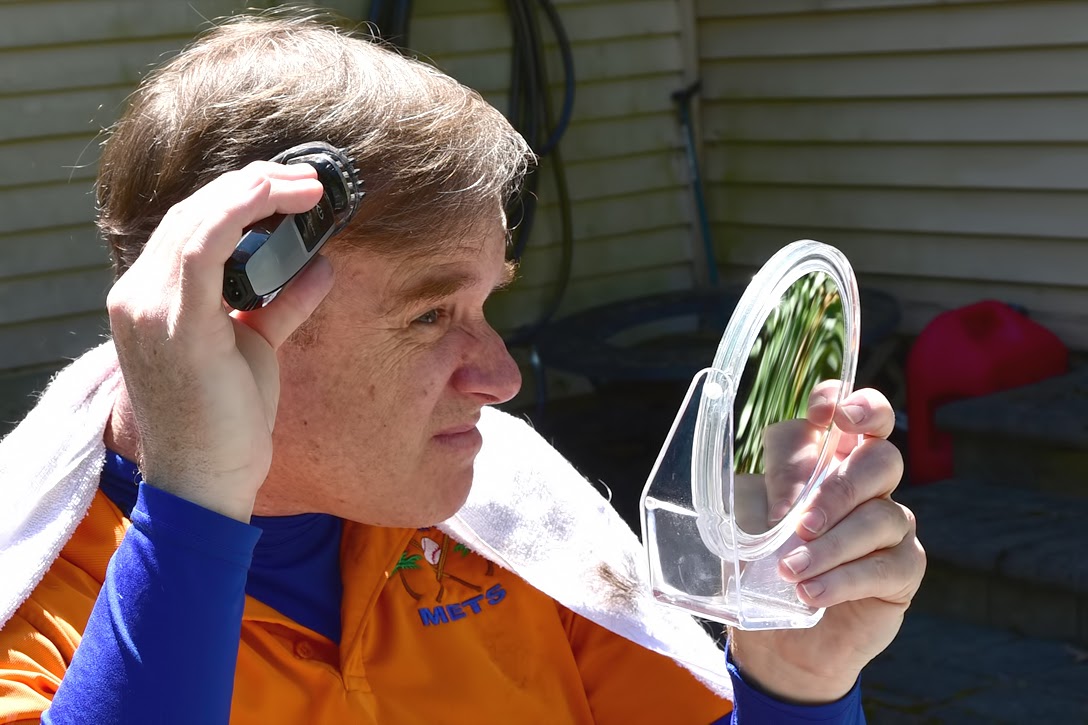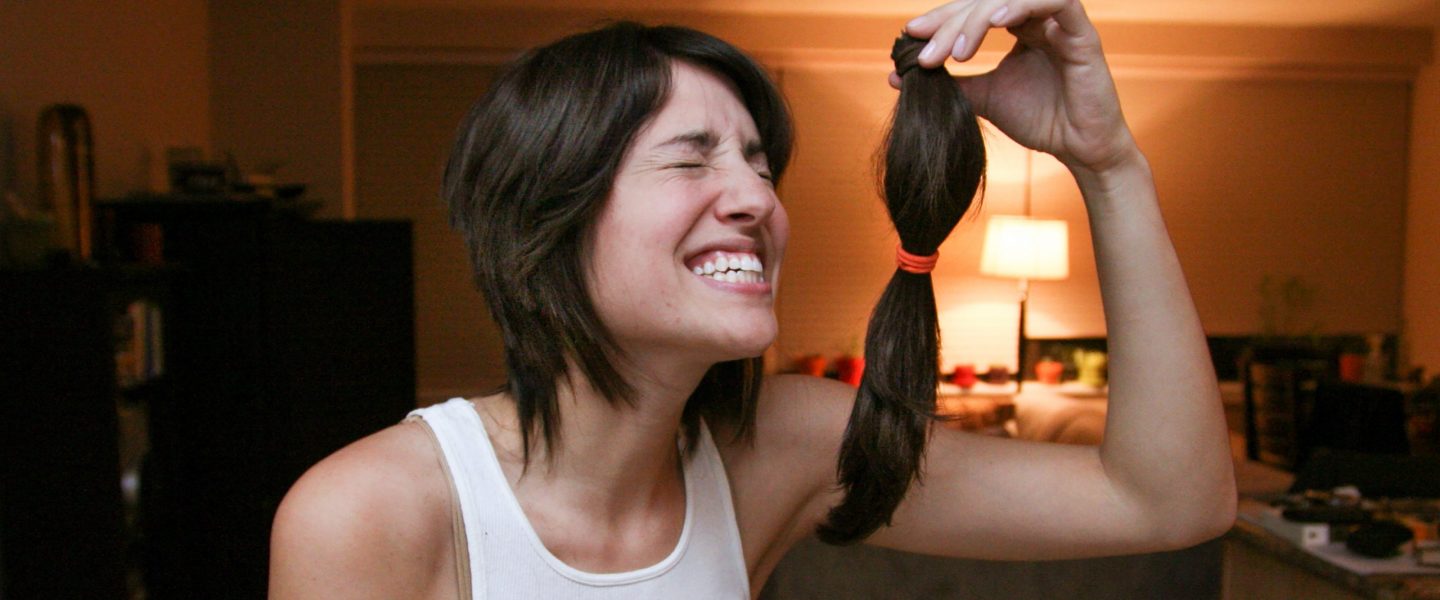“Give me a head with hair / long beautiful hair / Shining, gleaming, streaming / flaxen, waxen.” — Broadway hit musical Hair (1967).
Some names in this story have been changed.
Have you found yourself in shock recently after seeing a co-worker pop up in a Zoom window sporting two feet less hair than in a previous meeting? Maybe it’s a family member who shaved their head. Or your best friend who got a mohawk.
Throughout the ongoing stay-at-home orders issued across the United States as a result of the COVID-19 pandemic, one not-so-subtle trend has made its mark: the quarantine haircut.
Most everyone knows someone who cut their own hair, creating a radical change to their appearance as a way to relieve stress, regain a sense of control, or explore their identity.
Every so often, immediately after waking up, Britney Alterman will reach for the back of her head to tie her now-nonexistent ponytail. Or she’ll wash her hair, creating a sudsy mess, and realize she is using more shampoo than necessary. Maybe she’ll play with her hair, her fingers unconsciously probing for the feel of longer strands.
In June, Alterman stood in her bathroom, nervously snipping away strands of hair, millimeter by millimeter. And when the result wasn’t quite what she wanted, with the help of her boyfriend, over the following month she slowly turned longer hair into bangs and eventually into a short mullet. (For anyone who’s confused, yes, mullets are “in” again. In fact, they’re more than “in.” Have you seen Tiger King on Netflix? We are living in truly monumental times).
Social media was erupting with stories of others radically changing their hair. Middle parts. Bangs. Buzzcuts. Mohawks. Blonde dye. Pink dye. Blue dye. As a brewing pot of boredom, bravery, and self-exploration bubbled over, Alterman decided to be fearless.
“If a couple of years ago, you told me everyone was going to be alone in their rooms,” said Alterman, “I’d be like, everyone’s going to start getting crazy.”
In the midst of this pandemic, our thoughts, independent from the demands of a job or social environments, have space to roam free. And what happens when that space is used for a greater examination of self-identity? Haircuts, apparently.
Social media influencers have been drastically altering their looks, and a multitude of Facebook groups have popped up dedicated solely to the “quarantine haircut.” One of them, a 102-member group called “Haircuts in the time of the Plague,” was created after a friend of administrator Renee McHugh told her she’d gotten a “COVID cut” — an extremely short, done-at-home haircut. McHugh had done the same to her hair.
“I started the group because I felt like there were a lot of people in my shoes,” McHugh told WhoWhatWhy.
McHugh, who hails from Raleigh, NC, plays roller derby under the alias “Elektra-Q-Tion.” She’s met approximately 90 percent of her friends that way. So while being largely confined to her home, the Facebook group has been a good alternative way for McHugh to maintain a connection with others. Members post pictures of their haircut updates in Friday “roundups,” and in the process, have met others and developed friends.
“We’re just people trying to cope with [the pandemic] with a sense of humor,” McHugh said. “It’s not about changing the world — it’s just about making people feel a little better.”
Many others have taken to radically altering their hair at home. Hairstylists who’ve been in business on and off during the pandemic have also noticed clients opting to change their looks — sometimes drastically — more frequently than in the past.
In San Rafael, CA, Ann Brewer’s salon, Brewer Phillips Hair Design, was shut down for months after Gov. Gavin Newsom (D) enforced the closure of non-essential businesses. However, when doors briefly reopened for two weeks in July, the salon was overrun by a wave of regular clients — quantifiable by a stack of self-reporting COVID-19 symptom waivers nearly four inches thick.
In her 20 years of hairstyling experience, Brewer has seen some strange customers with some strange desires. Once, a woman came into her salon brandishing an index card with six individual strands of hair taped to the surface in an attempt to demonstrate how difficult a quality haircut would be. But this recent wave of requests was different.
Instead of the regular trims they were accustomed to getting every four to six weeks, in July, most of Brewer’s clients were requesting completely new looks, and she has theories about why.
“Our whole world has changed so much; we’ve all been forced into corners of our existence that we never thought we would go to,” Brewer said. “So I think it makes them feel a little more welcome, a little less afraid of change. If everything in your world has been blown up, maybe changing your hair isn’t so hard, right?”
According to Shaun Cole, associate professor of fashion at the Winchester School of Art in England, the fact that people would change their look in such unusual times makes perfect sense, since even under normal circumstances people often save specific appearances for specific social contexts. For example, someone might decide to sport a Hawaiian shirt on vacation, but wouldn’t think about sporting it in their day-to-day lives.

“For some people, [quarantine] will seem like that,” Cole said. “It will seem like this moment in time when they could do something different, they could experiment.”
For a younger demographic, being isolated from the social pressures of a school environment has been a surprise opportunity for self-discovery. Alterman, who just finished her sophomore year of college at the School of the Art Institute in Chicago, is bisexual and uses she/they pronouns interchangeably. Yet, for most of her life, she didn’t feel comfortable signaling her identity because she frequently found herself in relationships with men and didn’t feel “entitled,” as she explained, to present herself as part of the LGBTQ+ community.
Alterman, like many college students, was inspired by social media to change her hairstyle over quarantine. Specifically, Alterman cited TikTok as a platform that gave her a safe space to observe other people exploring their gender identities, and to build the confidence to express her own.
“I think it’s just a very natural thing that when you’re finding yourself attracted to a community of people, you’re paying attention to how they look and how you can sort of fit in and be able to feel close to those people that you’re admiring,” Alterman said. And, in her case, “a lot of those people happened to have mullets.”
Would Alterman and others have changed their hairstyles so radically if they hadn’t been isolated for months on end? In many cases, quarantine has offered a motivation (boredom) and presented an opportunity (social isolation) for people to finally get the hairstyle they’d been thinking of for a long time, yet were hesitant to try.
Many factors influence the way we groom, dress, and present ourselves in society; yet perhaps the most powerful factor is the desire to explore individual identity. That desire has been amplified during a period when the majority of us have largely been separated from external judgment and confronted by a radically altered world.
“People say, ‘I didn’t expect that of a person like you,’” Cole said, referring to an extreme change to one’s appearance. “People have expectations of who they think you are, and that impacts the person who you begin to think you are, and how you behave. I think this situation has allowed people to take stock and to think, ‘Well, is that who I am? Is that what I want?’”
In addition to confirming these motivations, Georg Eifert, professor emeritus of psychology at Chapman University, also affirmed the “positive” long-term psychological effects of exploring identity in order to develop self-confidence and resilience in the face of challenges.
“You will be more fearful of others and the opinion of others if you feel less comfortable and confident about yourself,” Eifert said. “When you start to look more inside yourself, you depend less on what is outside of yourself, including social judgments.”
According to Eifert, the key to feeling in control comes through internal change as opposed to external. However, an external change, such as a radical haircut, can be a conduit toward internal change if it allows a person to be creative and build self-awareness and self-esteem.
External changes, such as Alterman’s identity-affirming haircut, are examples of authentic self-expression that can help a person thrive. The reverse is also true: Authentic internal change sometimes leads people to adopt external changes that they feel celebrate their changed self.
Sue Dizon, 66, used to smile every time she caught a glimpse of her zinfandel-red hair, a style she’d developed during sessions every six months with close friend Brewer. After months spent indoors without the chance to schedule an appointment, the dye had slowly faded away, exposing a large streak of white.
“I don’t think of myself as an old person,” Dizon said. “So seeing all of this white s— coming out of my skull, it’s like, ‘Where did that come from?’”
The waiting period imposed by lockdown gave Dizon a chance to rethink her go-to shag cut, and she eventually settled on an idea based on the famous hairstyle of legendary American rocker Bonnie Raitt. When Brewer’s salon briefly reopened, Dizon made an appointment and had her hair re-dyed — this time the color orange, with her white streak untouched and prominently displayed. With the new look, Dizon said she has renewed confidence and a different outlook on her identity.
“Strangely enough,” she said, “the white actually made me feel younger.”
Recently, Cole, 53, has become interested in studying how age correlates with physical self-presentation. That interest is due to both professional and personal reasons; since his last haircut in February, his hair has grown considerably, and he’s begun to notice just how gray it is. However, that sight doesn’t bother him. In fact, quite the opposite.
“Societally, we have a real fear of age and aging,” Cole said. “You have to look at it as something different — does dyeing my hair to hide my gray actually artificially enhance my age in a way that I wouldn’t want it to?”
While societal beauty standards value youthfulness, and countless cosmetic procedures and products are available to allow consumers to look younger, it can be empowering to embrace a more natural appearance, including signs of aging.
As Cole put it, “Why do I have to bow to certain pressures?”
For some, exploring self-identity during quarantine has meant embracing the person they have become — yet for others, it has been a process of deciding who they want to be when it finally ends.
Chapman University student Kia Wallace wishes more people were around to see her hairstyle, which for her is as much a signal of personal growth as it is a change in appearance. About a month ago, Wallace dyed her hair blonde at home. Throwing caution to the wind, Wallace used six boxes of dye until the blonde color eventually morphed into a ginger-orange. Since making the change, she said she feels “way more confident,” even though hardly anyone has seen her new look.
Coinciding with a change in personal style, Wallace has tried to hone in on her self-identity over quarantine — or at least the image of herself she wants to present once life returns to normal. Left to interact with only her family, her dog, and — most frequently — her inner thoughts, she’s become committed to positive self-change, including righting mistakes that she feels she’s made in the past.
“I’ve been going back and apologizing to people that I’ve hurt and I’m trying to change for the better,” Wallace said. “I feel like I’m kind of leaving a part of myself behind by dyeing my hair because it’s really a new physical image, but I’m also trying to work on my spiritual one as well.”
In a chaotic time that’s often left people with little to do other than a brisk twiddle of the thumbs, a change in hairstyle can be a simple way to fight boredom and anxiety, or to feel in control. It can represent a self-image people want to present for themselves or others. It can even inspire internal change, as our busy daily lives have slowed down, forcing us to become more introspective. And if something goes terribly wrong in the process of dyeing or cutting — who cares? It doesn’t have to be a permanent change.
“The thing about hair that’s interesting is, if you cut it off,” Cole said, “it can regrow.”
Does Alterman plan to let her coffee-toned hair again flow down to her back, or has her new style – the shorter, commanding, scene-stealing, cropped mullet – slowly become her preferred look? In truth, only her hairdresser knows for sure.
Related front page panorama photo credit: Adapted by WhoWhatWhy from Marco Verch / Flickr (CC BY 2.0)



